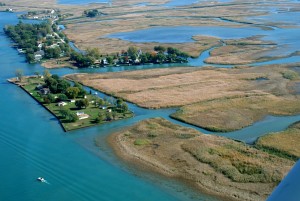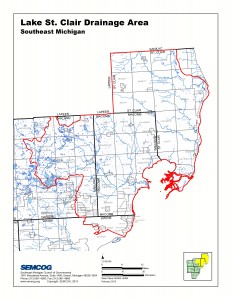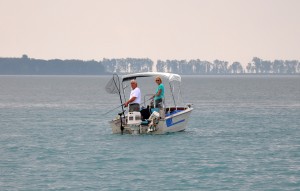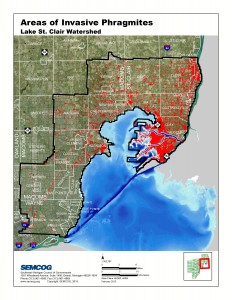William Parkus, Southeast Michigan Council of Governments
February 2015

St. Clair Flats Coastal Wetland Complex inundated with Phragmites. Photo courtesy of Clay Township Phragmites Advisory Board
Southeast Michigan’s natural resources are significant but are under siege from the aggressive Phragmites australis, which is infesting the landscape and threatening our recreation-based economy. Along our Great Lakes shoreline, Phragmites australis is invading our coastal shorelines, wetlands, channels, and coastal tributaries. In 2009, Ducks Unlimited mapped 12,000 acres of Phragmites around Lake St. Clair with more than 8,000 acres in the St. Johns Marsh, St. Clair Flats area of Clay Township alone.
Our strategy for controlling the spread of Phragmites is to develop a series of locally-based management structures called CISMAs – or, Cooperative Invasive Species Management Areas. These CISMA’s are partnership based management structures that operate in their own geographic boundaries but would coordinate and share resources. A CISMA is now being set-up within the Lake St. Clair Watershed.
Developing the Lake St. Clair CISMA
The Lake St. Clair CISMA is being developed within the organizational structure of the existing Lake St. Clair/St. Clair River Protection and Restoration Partnership. A steering committee has been established to carry out the management activities of the CISMA. The Steering Committee coordinates implementation (e.g., securing funding) of invasive species projects received from stakeholders such as government agencies, nongovernmental organizations and private property owners, or received directly from the Partnership. The Steering Committee will develop an annual work program that guides management actions.
Initial funding for management activities of the CISMA are being sought through the Department of Natural Resources Invasive Species Grant program. The grant proposal, if awarded, will control Phragmites on 1,800 acres of land, including Great Lakes Marsh, as well as fund a full time program coordinator.

The CISMA operates within the boundary of the Lake St. Clair watershed. Image courtesy of the Southeast Michigan Council of Governments
The operational area of the CISMA will follow the Lake St. Clair watershed boundaries in Southeast Michigan. Membership in the CISMA requires signing the Partnership Agreement. Participation on the CISMA Steering Committee is a voluntary activity open to all Partners with an invasive species infestation problem.
We understand all too well that we will fail at turning back the Phragmites invaders if we don’t reach across the jurisdictional boundaries and work with our municipal neighbors, organizations and residents. Very few single communities, agencies or organizations have the resources to mount a sustainable management offensive by themselves. It will take all parties collaborating and sharing resources if we are to truly reach a point of control. Once controlled though, a single local community should be able to manage re-growth of Phragmites through its various operations and maintenance budgets – if the community remains vigilant and has an aggressive maintenance program.
The Lake St. Clair CISMA, will get an opportunity to start practicing what we preach shortly. The Oakland County CISMA has formed immediately west of us. Once the Lake St. Clair CISMA is fully formed, we will begin discussions on coordination and resource sharing with our Oakland County counterpart. We believe this will allow us to have better coverage and more effective management efforts.

Lake St. Clair – A $2 billion fishery contributing to the local economy. Photo courtesy of the Southeast Michigan Council of Governments
Editors Note: Work by this CISMA is continuing. Check out an update published March 8, 2016.

